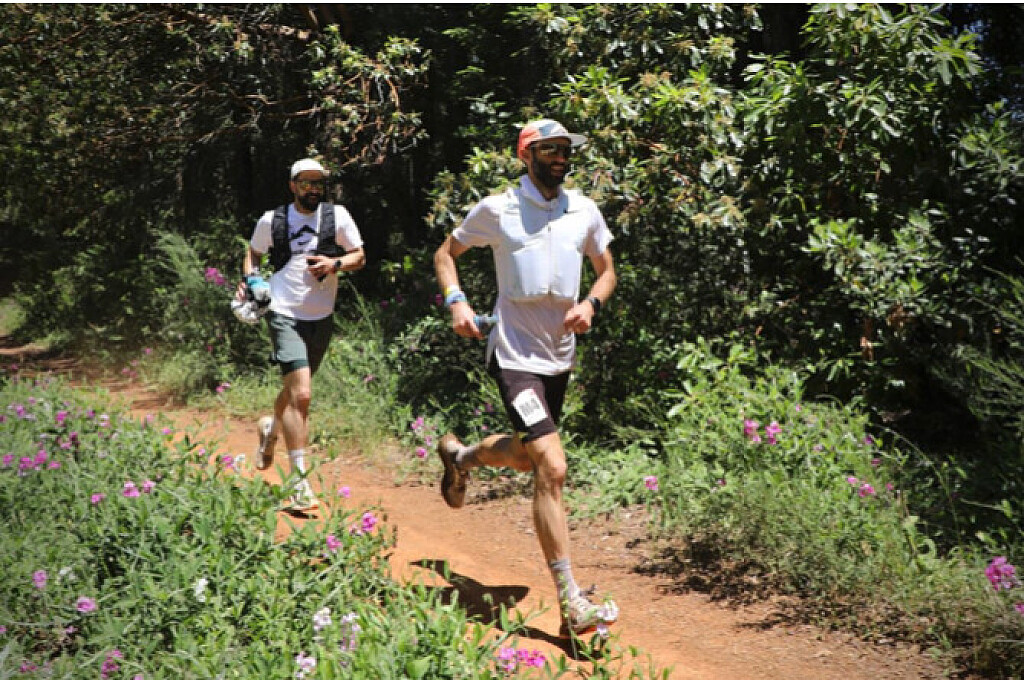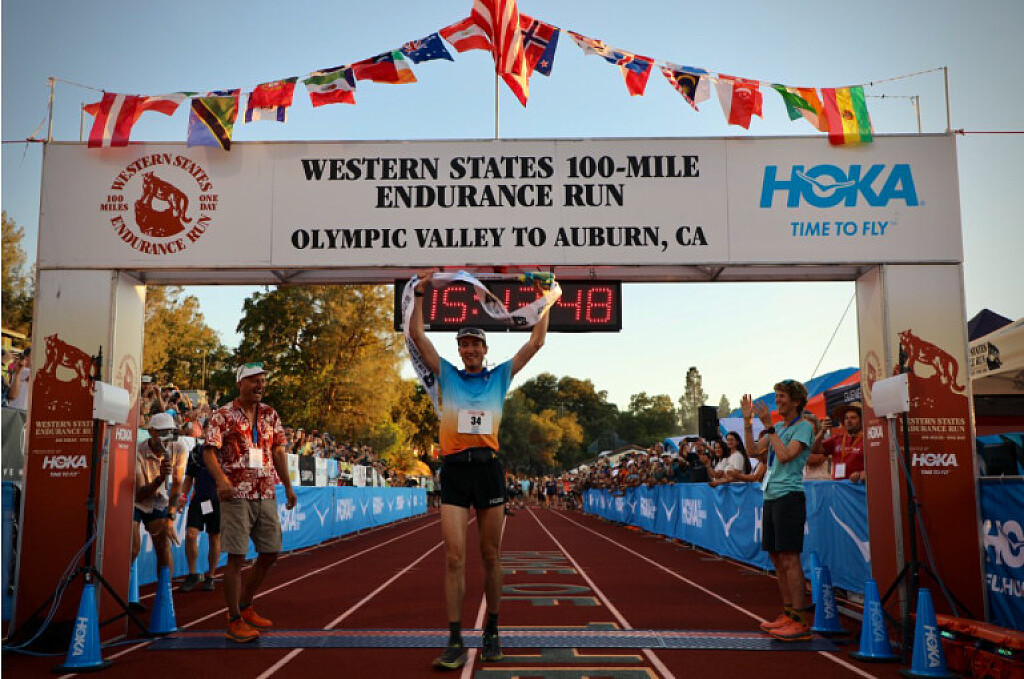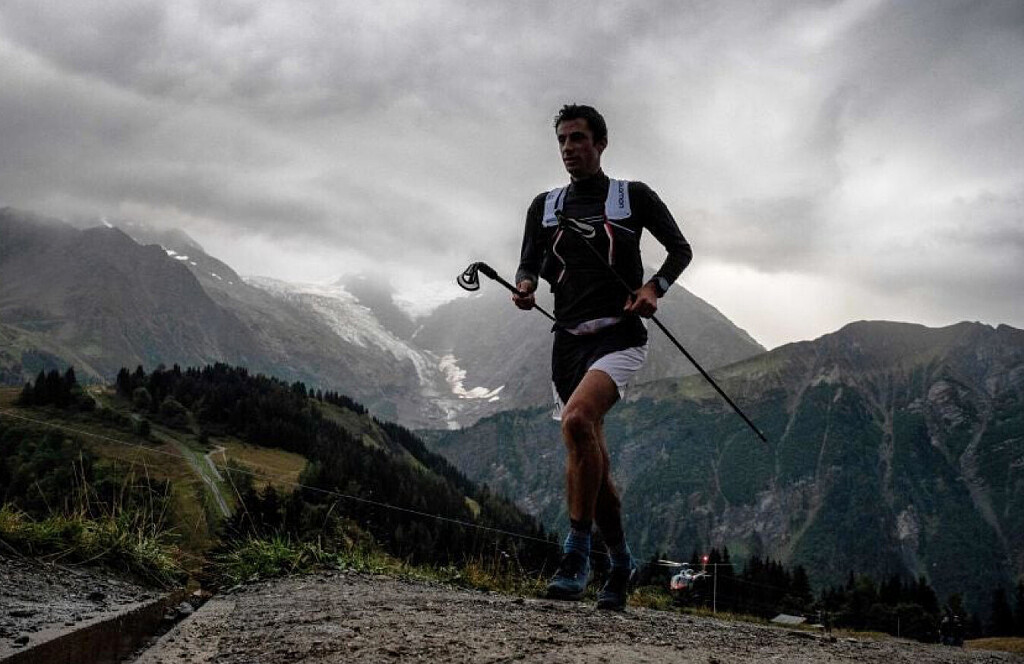Running News Daily
Running News Daily is edited by Bob Anderson. Send your news items to bob@mybestruns.com Advertising opportunities available. Train the Kenyan Way at KATA Kenya and Portugal owned and operated by Bob Anderson. Be sure to catch our movie A Long Run the movie KATA Running Camps and KATA Potato Farms - 31 now open in Kenya! https://kata.ke/
Index to Daily Posts · Sign Up For Updates · Run The World Feed
Articles tagged #Jared Hazen
Today's Running News
2023 Western States 100 Men’s Race
There’s nowhere to go but up at the start of the Western States 100, and Jia-Ju Zhao from China charged the opening climb. Despite snow, Zhao hit the top in 42 minutes. Slower to the top, Frenchman Mathieu Blanchard (pre-race interview) and Brit Tom Evans (pre-race interview) turned to greet the brilliant sunrise together.
Zhao won the Ultra-Trail Mt. Fuji 100 Mile in April 2023 and is a two-time winner of the Doi Inthanon by UTMB 100 Mile in Thailand. He pushed his early lead to five minutes at Lyon Ridge, mile 11, while 2022 fourth-placer Tyler Green led the early chase group. Green had finished as high as second here before, in 2021, but was running more aggressively toward the front earlier than ever before.From mile-15 Red Star Ridge to mile-25 Duncan Canyon, the chase group started to make up time on Zhao. Tom Evans, Chinese runner Jia-Sheng Shen, and Dakota Jones (pre-race interview) were among a group that cut four minutes from Zhao’s lead over just nine miles. Evans was third here in 2019 in 14:59, and Jones had just biked 680 miles from his home in Utah to the race start.
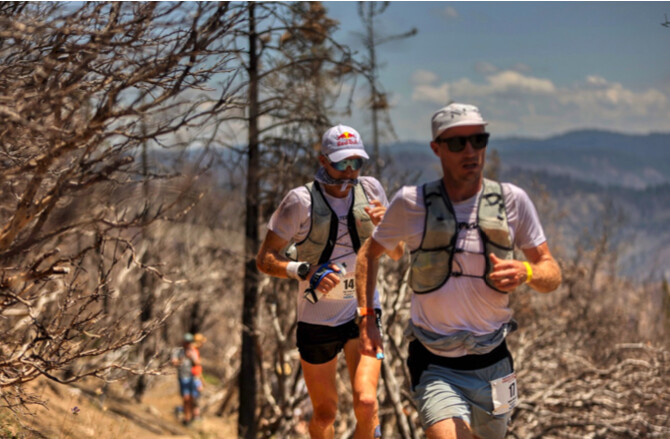
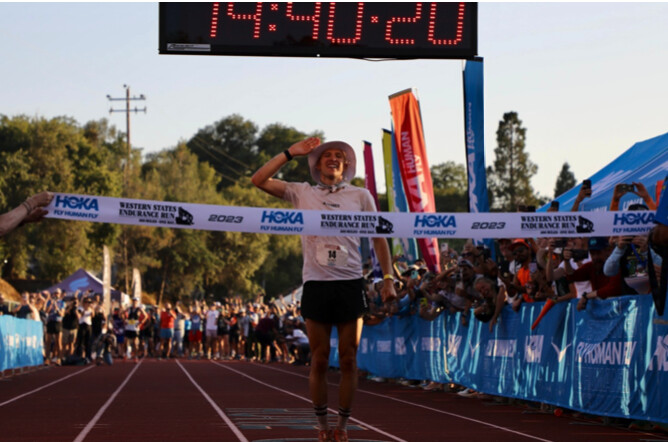
Zhao was quickly swallowed up in the next five miles to Robinson Flat, mile 30, and soon fell out of the top 10. A lead trio of Tom Evans, Dakota Jones, and Jia-Sheng Shen came into aid at 4:45, meeting their crews for the first time. At mile 30 and with Zhao falling backward, Anthony Costales (pre-race interview) was fourth, and then he was with Tyler Green at mile 38 in fourth and fifth. The two would barely separate the rest of the race.Evans and Jones dropped Shen on the climb to Devil’s Thumb, mile 48, and the two leaders came into aid together in 7:03. Four minutes back Costales had caught Shen on the big climb, and Tyler Green, Jeff Colt, New Zealand’s Daniel Jones, Ryan Montgomery, Mathieu Blanchard, and 47-year-old Ludovic Pommeret were inside the top 10. Those six were 14 minutes apart. 2022 third- and second-place finishers Arlen Glick (pre-race interview) and Hayden Hawks (pre-race interview) were back in 11th and 16th, respectively. After earlier moving up, Hawks had just lost several places and would later drop with injury at mile 55. Other top-10 finishers from 2022 Cody Lind, Scott Traer, and Alex Nichols were all noticeably outside the top 10 too.
As the race shifted to its mile-62 Foresthill hub, Evans gained some separation on Jones and entered the aid station first, but as Evans changed shoes and socks, Jones didn’t wait and exited first. Jones was now in the lead by himself for the first time and he was overheard voicing his intention to break Evans. Some 11 minutes back of those two leaders, Green and Costales were again together and in third and fourth. Shen and Jeff Colt were just minutes back of those two, and Colt was remarkably almost an hour faster than a year ago when he finished 11th.Jones and Evans separated leaving Foresthill and anticipation ran high for their next steps. The two had been together for nearly the entirety of the race to this point. Jones wanted to make a move and Evans wanted to keep up with (the) Jones. The duel ended quickly and dramatically though. Tom Evans dropped a 5:54 downhill mile and hit Cal 2, mile 71, in 10:12. That surge pushed Jones eight minutes back at mile 71. It was just nine miles from Foresthill to that split on Cal Street, but the front two had shattered and moved in opposite directions the rest of the race.
Evans ran alone to the river crossing at mile 78, and ultimately to the finish. Tyler Green, Anthony Costales, Jeff Colt, and Jia-Sheng Shen all overtook Dakota Jones on the way to the river too. Forget about Elm Street, Jones was having a bit of a nightmare on Cal Street.
Evans, the 2022 UTMB third placer, continued to put time on the field the rest of the way. He finished in 14:40 and that’s the race’s fourth fastest finish ever. The mark trails only Jim Walmsley and Jared Hazen in 2019, and Walmsley’s 2018 mark too. Evans was a runaway winner, but the rest of the top 10 was much more closely packed.Tyler Green pushed on in second, and held off an Anthony Costales chase over the last 15 miles. Green finished in 15:04. It was his second runner-up finish and a big personal best for the course. He was able to finish with his baby boy on his shoulders. Green’s 15:04 was the race’s 11th-fastest finish ever. Costales was third in 15:09, the race’s 13th-fastest finish ever.
Jia-Sheng Shen and Daniel Jones both finished fast. Shen clocked 15:19 and Jones was fifth in 15:22. Mathieu Blanchard and Ryan Montgomery both overtook Jeff Colt late. Those three — Blanchard, Montgomery, and Colt — finished in 15:37, 15:38, and 15:42, respectively. Local runner Cole Watson bettered his 2022 14th-place finish with a ninth-place 15:54.
In 2019 the top 10 all went under 16 hours. This year’s 10th-place man Janosch Kowalcyzk from Germany just missed matching that feat. He finished in 16:09.
Seven of last year’s top 10 returned, but only Tyler Green was able to again make the top 10. The 2022 top 10 finishers Ludovic Pommeret, Arlen Glick, Scott Traer, Cody Lind, and Alex Nichols finished 12th, 13th, 15th, 16th, and 28th this year, respectively. As earlier mentioned, 2022 runner-up Hayden Hawks dropped.
After running near or in the lead through Foresthill, Dakota Jones finished 17th in 17:00.
Early leader Zhao’s high risk, high reward start ended with a drop at Michigan Bluff, mile 55.
by Justin Mock I Run Far
Login to leave a comment
Western States 100
The Western States ® 100-Mile Endurance Run is the world’s oldest and most prestigious 100-mile trail race. Starting in Squaw Valley, California near the site of the 1960 Winter Olympics and ending 100.2 miles later in Auburn, California, Western States, in the decades since its inception in 1974, has come to represent one of the ultimate endurance tests in the...
more...2022 Western States 100 Men’s Race
This year’s men’s race had the notable absence of course record holder Jim Walmsley, who has dominated the race in recent years, leaving it wide open for a good number of runners with potential to win. Among them were seven of last year’s top 10, including second-place finisher Tyler Green, and Tim Tollefson, who was fifth last year but hotly fancied to be capable of winning this race on a good day. Last year’s eighth place man, Hayden Hawks, who ran Western States as his debut 100 miler, was also believed to have more to offer in this race.
Notably, joining them as a Golden Ticket entrant was Jared Hazen, the second fastest Western States finisher of all time.
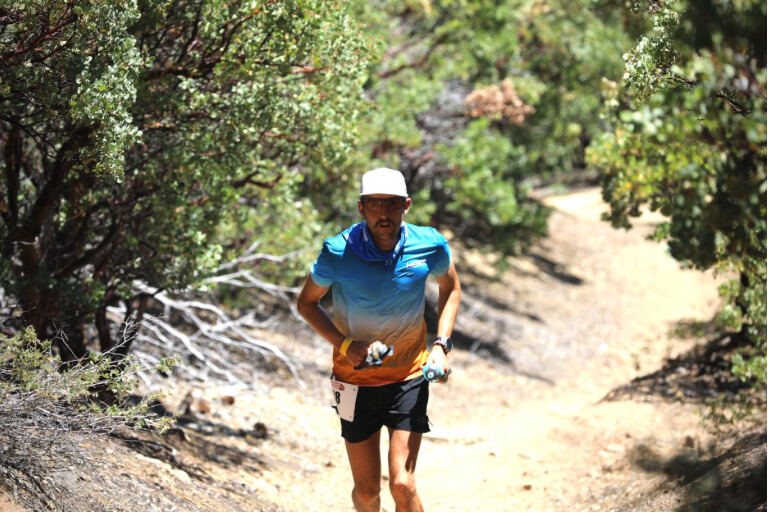

And last but certainly not least, the relative new kid on the block, who has quickly shot up through the distances and dominated every ultra he’s ever started — Adam Peterman.
Peterman won his way into Western States at the Canyons by UTMB 100k, where he toppled the course record in his first ever 100-kilometer race. He took a gamble by taking on his first 100 miler a little over two months later, and defended the decision to iRunFar in his pre-race interview saying: “I don’t feel like I always need to just make logical steps because we’re running 100 miles, that’s an illogical game.”
The first 3.5 miles of Western States features 2,550 feet of climbing, to the first landmark at the Escarpment. First to the top was Adam Kimble, closely followed by France’s Ludovic Pommeret — with Hawks, France’s Seb Spehler, and Hazen coming through in quick succession.
Tollefson, Tom Owens (U.K.), Peterman, Jonathan Rea, and Alex Nichols completed the front 10, all within a couple of minutes of each other.
By Lyon Ridge at mile 10, Ludovic had taken the lead and he came through Red Star Ridge at mile 15, four minutes clear of Spehler in second, with Kimble in third, and Hawks and Tollefson a few minutes back, followed by Hazen, Peterman, and Arlen Glick. Nine minutes separated the first eight runners to this point.
The two Frenchmen held the top positions into mile 24, just before Duncan Canyon, with Pommeret coming through six minutes off course record pace. At this point Tollefson had moved up to third and Hawks and Peterman sat comfortably in fourth and fifth, 8:10 back from the lead, with Glick following 10 seconds behind.
Pommeret held the lead into Robinson Flat, mile 30, with the pressure starting to show. Hawks had moved up to second by now and was looking a lot more comfortable, just two minutes back from the leader. Peterman had then moved up the field also to third position, just in front of Spehler, who’d dropped back to fourth, with Tollefson seconds behind. This chasing pack were just four-and-a-half minutes off the leader.By Millers Defeat at mile 34, Hawks had closed the gap to a minute, and by Dusty Corners, mile 38, he’d taken the lead from Pommeret.
Through Deadwood Cemetery, mile 49.5, Hawks maintained the lead and looked like he was having a super day. There had been some reshuffling in the other top positions, with Peterman, Hazen, and Glick all still in the mix.
By Foresthill, mile 62, Hawks was still in the lead but Peterman had separated himself from the other chasers in second. He arrived just three minutes back from Hawks and almost eight minutes clear of Hazen in third. Spehler, who had a promising first half, had dropped back the field suffering stomach issues, and Tollefson had also fallen back from the front runners.
Hawks was still in the lead after Foresthill, but by Cal 2, mile 70, Peterman had joined him at the front and the race was on! Hazen held third place, 14 minutes back from the leaders, with Glick in fourth another 15 minutes back from Hazen.
When the race reached the Rucky Chucky river crossing at mile 78, Hawks still looked comfortable but Peterman had stretched four minutes ahead, putting 30 seconds per mile on his opponent since Cal 2, showing unbelievable strength and determination for a 100-mile debut.
Hazen maintained third position, now 24 minutes off the lead, with Glick and France’s Vincent Vietmaking up the front five.
Hazen had started to struggle and dropped out at mile 85, with Glick moving up to third. Peterman had by now extended his lead to 10 minutes.
The top three positions remained unchanged for the remainder of the race, but Peterman utterly dominated in the closing miles, finishing in 15:13:48, almost 34 minutes clear of Hawks in 15:47:27. Glick rounded out the top three in 15:56:17.
t’s clear from this 100-mile debut that we will be seeing a lot more of Adam Peterman. He executed this win in a similarly patient manner to his win at the Canyons 100k, and he races like a runner with a lot more ultrarunning experience than he has.
Moving up all race again, Green ended the day in fourth position in 15:57:10, what was two places back but some 13 minutes faster than his debut at this race last year. Drew Holmen (pre-race interview) finished fifth after a strong, all-day performance. His 16:09 finish this year is also two places back but 14 minutes faster than last year. These two gentlemen have much in common.
Frenchman Pommeret stayed strong to finish in sixth place and first masters, and he was closely chased by fellow Frenchman Viet. Nichols moved up two spots this year to take eighth. Cody Lind moved back from fourth last year to ninth this year. And Scott Traer meted out his race effort perfectly to run his way into the men’s top 10 for 10th place.
Men’s DNFs included Spehler and Hazen, both due to various physical issues.
Login to leave a comment
Western States 100
The Western States ® 100-Mile Endurance Run is the world’s oldest and most prestigious 100-mile trail race. Starting in Squaw Valley, California near the site of the 1960 Winter Olympics and ending 100.2 miles later in Auburn, California, Western States, in the decades since its inception in 1974, has come to represent one of the ultimate endurance tests in the...
more...Kilian Jornet Announces Return to UTMB for 2022
"Return of the King."
That was the title of a YouTube video tweeted out by UTMB on February 23 to announce Kilian Jornet's return to the legendary race in Chamonix.
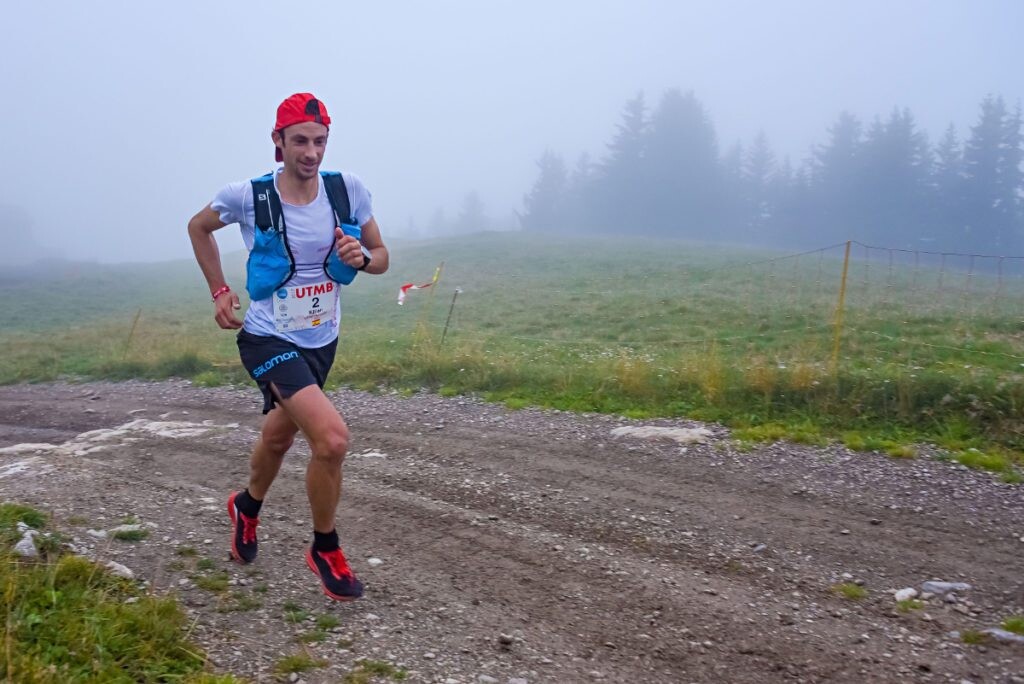
"This year I'm coming back to UTMB," said Jornet, in a clip sprinkled with quotes touting him as the sport's greatest of all time. "Why, you will ask me: it's because I really love to suffer. I really love the pain in the legs, the feet, and everywhere in the body. That's what long distance is about. To enjoy the pain!"
It will be Jornet's first time back at the 105-mile (170K) race since 2018, when he dropped 11 hours in. He has raced UTMB six times since 2008, including victories in 2008, 2009, and 2011. In 2017, he broke the race's course record while finishing second to Francois d'Haene's 19:01:54 and becoming the second man ever to break 20 hours on the course in 19:16:59.
The 2022 edition of UTMB is slated for August 21-28, with the 105-mile flagship race kicking off on Friday, August 26. It will come just six weeks after Jornet's appearance at the Hardrock 100 on July 15, where he will go after another win to complement those from 2014, 2015, and 2017 (as well as a co-victory with Jason Schlarb in 2016, when the two finished hand-in-hand).
Other athletes expressed their excitement for Jornet's return in the Twitter video.
"It would be a bit empty if Kilian wasn't there, to be honest," said Tim Tollefson, who will also race UTMB in August. "He is the king of the sport, so it just feels right to have him on the line."
Once August rolls around, Jornet will compete against one of the strongest fields UTMB has ever seen. Two-time champion Xavier Thevenard of France and an American contingency including Tollefson, Jim Walmsley, Jared Hazen, Sage Canaday, Dylan Bowman, Jason Schlarb, and Cody Reed will all be aiming for a podium finish. On the women's side, Americans Camille Herron, Brittany Peterson, and Hillary Allen will be in attendance, as well as Beth Pascall of the U.K., Audrey Tanguy of France, and Ragna Debats of the Netherlands.
"UTMB always has such a big level, so many good athletes, so I really love this competition," said Jornet in the video announcement. "I'm really looking forward to being at UTMB again this year."
by Trail Runner Magazine
Login to leave a comment
2021 Western States 100 Men’s Race
It would have taken a lot to convince most everyone to bet against Jim Walmsley (pre-race interview) this year. And yet some of us still somehow did, because Walmsley took an unconventional path to 2021 success. But we all should have known better.
With many of the international men choosing not to make the trip over the various ponds, it was going to be a showdown of domestic talent. Listening to Walmsley talk before the race, it was clear he was in a good place mentally and physically. An IT band injury in the spring may have cut down on his training volume, but in the end, it may have ended up being a blessing in disguise. He went into the race with the experience of two well-executed States performances, and he surely he drew on that knowledge to put together a smart and measured race from start to finish.
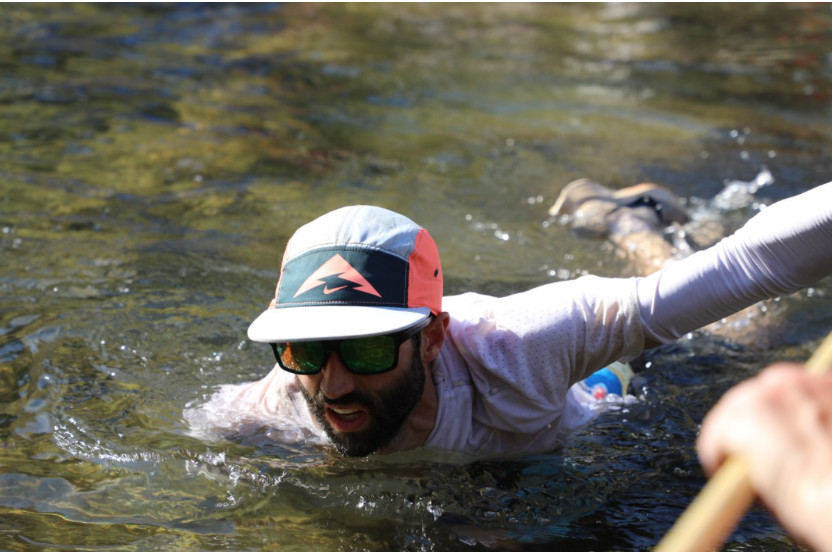

Hayden Hawks (pre-race interview), on the other hand, was making just his second attempt at the 100-mile distance. But after setting a course record at the JFK 50 Mile last fall and a solid block of training leading up to Western States, he was out to race and win. Jared Hazen (pre-race interview) was hoping that fourth time would be the charm for Western. After a third and a second in previous years, he hoped that a training block that started in February would deliver results.
It didn’t take Walmsley long to make it the 3.5 miles up to the Escarpment. He was accompanied by Hawks and followed closely by Hazen. This order was entirely unsurprising given that all three men had the confidence to try to win the race.
Early on at Red Star Ridge at mile 15, Hawks and Walmsley were already running three minutes under record pace, the lack of snow clearly saving them time. Hazen followed in third two minutes back with other race favorites Tim Tollefson (pre-race interview), Matt Daniels (pre-race interview), and Mark Hammond close on his heels. Just under an hour later at Duncan Canyon, Walmsley and Hawks had pushed the pace another four minutes under record pace, both running smooth at 24 miles in.
By Robinson Flat at mile 30, Walmsley’s pace had become too much for Hawks. He passed through five minutes under course record pace and 45 seconds in front of Hawks. By this time, Tollefson, running toward his childhood home in the foothills of the Sierra Nevada, had moved into third, just over 12 minutes back, looking very relaxed. Thirty seconds later, Hazen came through, already looking decidedly rough.
Sometime before mile 38, Walmsley had donned a bucket hat and continued to cruise at six minutes under record pace, slowly pulling away from the rest of the field. Hawks held the gap to just six minutes while Hazen and Tollefson joined forces nearly 17 minutes back. The likes of Alex Nichols (pre-race interview), Drew Holmen, and Max King stayed close, just another seven minutes back.
By mile 50, Walmsley had put eight minutes into the course record. Maybe it was the bucket hat, but the only word to describe his appearance was relaxed. It was a full 26 minutes later before second place Hawks rolled through, still seemingly running within himself. Nichols led Tollefson through, both looking strong. Hazen continued to suffer, dropping back to fifth.
By the time the leaders rolled through Foresthill at mile 62, it was 93 Fahrenheit in the shade and 97 in the sun. It was time for the heat management strategies to come into play. “It’s not the heat, it’s the hills,” said Hawks, coming through after losing 10 minutes to Walmsley in the previous five miles. He was now 48 minutes back and had Nichols to contend with who was slowly closing the gap.
That ever-infamous Cal Street, stretching between Foresthill at mile 62 and the Rucky Chucky river crossing at mile 78, is where the day started to catch up to Walmsley—just a little bit. At the Cal 2 aid station, he’d given back his advantage on the course record. From there on out, he moved faster than everyone else behind him, but slower than a 2019 Walmsley.
By Green Gate at mile 80, Walmsley was five minutes over course-record pace. But Hawks came through a full 77 minutes back. A surging Holmen was just 11 minutes behind and didn’t even stop. This was his first attempt at 100 miles, and he’d clearly done his homework on pacing and patience. Tyler Green was close behind. With a 14th-place finish at Western States in 2019, Green was on a mission to do better.
By the time Walmsley made it to Robie Point, just a mile to go, and with the course record was off the table, he stopped for a Coke and walked the climb. He would continue to cruise the final mile in his bucket hat to win his third Western States in a row with a time of 14:46:01.
Behind him, the race for the podium stayed intense. Somewhere between Green Gate and Pointed Rocks at mile 94, Hawks disappeared from the front of the race, leaving Green in second place with Holmen chasing just six minutes back. Cody Lind followed in fourth and just 17 minutes back.
At the end, Green would hold off Holmen with a time of 16:11:00 to take second, a massive jump up from his 2019 finish. Holmen completed the podium with a time of 16:23. Both had started off conservatively and had it pay off in the end.
Lind would finish fourth in 16:49:40, an impressive run for his first 100 miler and first attempt at Western States. He clearly had insider’s knowledge as the son of two-time Western States finisher Paul Lind and the grandson of the event’s original medical director Dr. Bob Lind.
Tollefson rounded out the top-five men with a time of 16:55:49. He’d put off running Western until he felt ready to do the race justice, and clearly, he was ready. The fact that he’d grown up in the area and run the last miles of the course hundreds of times certainly paid off in the race’s most difficult miles.
In the back half of the men’s top 10, we had sixth-place Kyle Pietari, who executed yet another well-played top-10 performance, Stephen Kersh who finished seventh for the second time in a row after curiously bouncing around almost all the top-10 positions over the course of the day, and Hawks who ultimately crossed the line in eighth place after experiencing physical struggles and a long stay at the mile 94 aid station to regroup.
Among the day’s breakout runs was ninth place Kyle Curtin, who moved up into the top 10 late. And Nichols rounded out the top 10 in what looked like a difficult finish after an even more difficult day.
And just to clear the air for those wondering, Daniels DNFed at mile 55. Hazen and Jeff Browning left the race at mile 62. And Hammond and King tapped out at mile 80.
by I Run Far
Login to leave a comment
The Western States 100 Is Back and It’s Going to be HOT!
Western States is famously competitive - and this year is shaping up to be one of the toughest competitions yet with hot temps, and a stacked field.
Jim Walmsley and Magda Boulet will be back at the Western States Endurance Run this week.
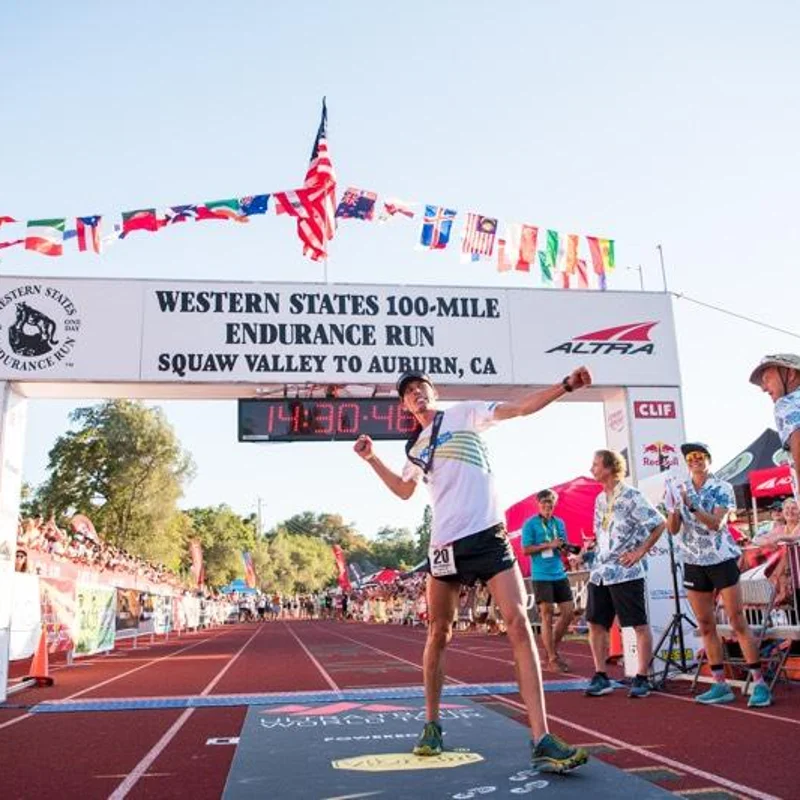
And so will Clare Gallagher, Patrick Reagan, Max King and Brittany Peterson. And, so too is race pioneer Gordy Ainsleigh and 312 other inspired runners who have been training for more than a year and a half to get to the starting line. In fact, we’re all heading back to the Sierra Nevada range this weekend — even if vicariously — to what feels like a bit of normalcy returning.
After a year mostly away from the trail racing running scene, things are starting to feel like old times. With stacked men’s and women’s fields, scorching heat in the forecast and last year’s Covid-19 hiatus hopefully mostly behind us, it’s definitely the event the ultrarunning community has been looking forward to. The race begins at 5 a.m. PST on June 26 and it looks like it’s going to be an epic one. (Follow via live tracking or the live race-day broadcast.)
“Yeah, it will be good to be there and see people and actually be in the race,” says Walmsley, who won the race in 2018 and 2019 in course-record times. “It’s been an odd year.”
Odd for sure, but with deep men’s and women’s fields, hot weather, dusty trail conditions and the late June gathering of a few hundred runners on this hallowed ground feels somewhat normal. The mountains and canyons in and around Olympic Valley northwest of Lake Tahoe have been a sacred place for the native Washoe people for thousands of years before Gordon Ainsleigh’s first romp over the Western States Trail in 1974.
It’s been an especially odd year for Walmsley, who, for the second straight year, had planned to use the first half of his year training for the 90K Comrades Marathon in South Africa. But that was canceled last year (with just about every other big race, including the Western States 100) and this year, too.
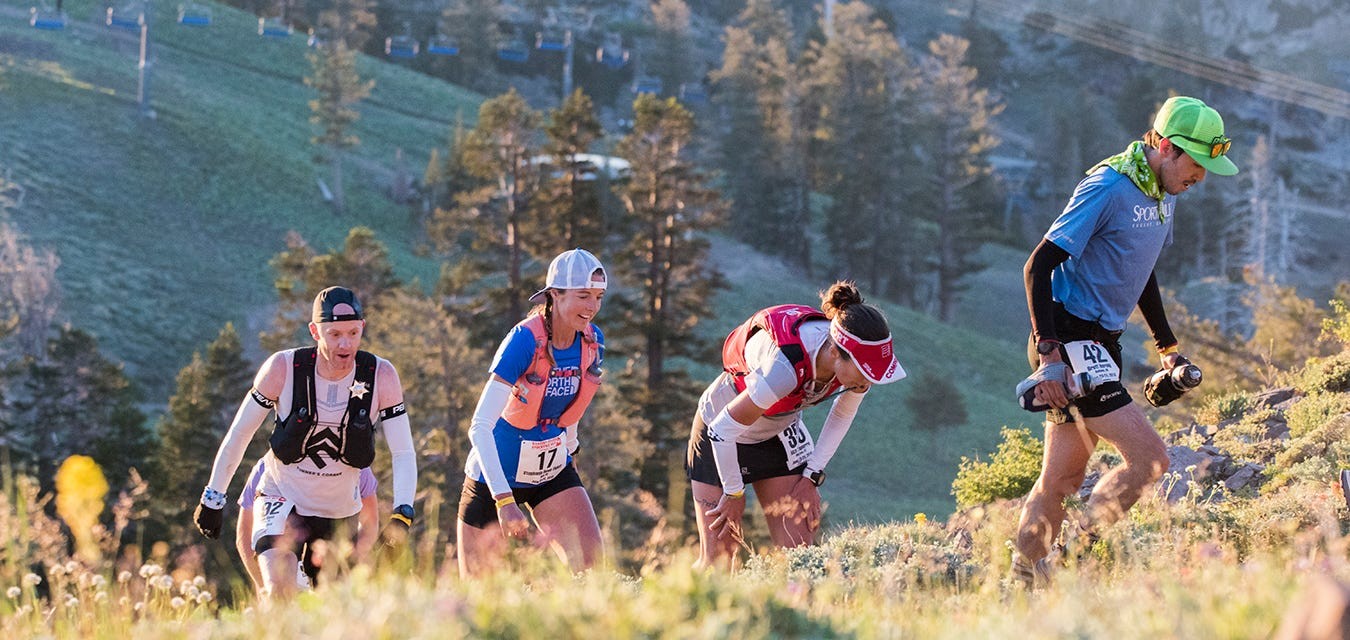
So instead, after setting a new U.S. 100K road record in January, he took a sponsor’s entry into the Western States 100 from HOKA One One and will be once again lining up in America’s most celebrated trail running race. With notable first-timers Tim Tollefson and Hayden Hawks in the mix along with Walmsley, Reagan, King, Matt Daniels, Alex Nichols, Kyle Pietari, Mark Hammond, Stephen Kersh, Jeff Browning and Jared Hazen all returning with previous top-10 finishes, on paper anyway, the men’s race is shaping up to be one of the most competitive in recent memory or maybe ever, even though it’s comprised entirely of domestic runners.
The women’s race might be even more competitive with former champions Boulet, Gallagher (2019) and Kaci Lickteig (2016) leading the way, plus elite American runners Camille Herron, Addie Bracy, Camelia Mayfield and Keely Henninger and international stalwarts Ruth Croft (New Zealand), Audrey Tanguy (France), Beth Pascall (UK), Emily Hawgood (Zimbabwe), Kathryn Drew (Canada) and Ragna Debats (Spain) joining the fray.
Who are the favorites? It’s hard to tell. Most of those runners, including Walmsley and Boulet, have admitted to having dealt with some minor injuries, inconsistent training, a lack of motivation and other setbacks over the crazy year that was. Based on what runners have been reporting, it seems like most are just eager to get back and immerse in a competitive 100-miler and see what they can do.
However, one of the keys will certainly be who can survive the heat the best. The forecast is calling for high temperatures in the upper 80s to the high 90s on Saturday after and the canyons between Robinson Flat and Michigan Bluff could even reach over 100 degrees.
Walmsley has said he’s dealt with some IT band issues and has focused mostly on running with a lot of vert, focusing on getting optimal recovery, strength sessions and body work, as well as spending as much time running in extreme heat as possible. That includes running and hiking countless laps to the summit of 9,298-foot Mt. Elden in Flagstaff, averaging 20 to 25 hours per week on the trails and also spending a lot of time on a bike trainer.
But he’s also spent a lot of time in the infrared sauna in his home and spent time with family in the Phoenix area, where he ran in the afternoons amid 115- to 120-degree heat.
“The heat training is kind of lucky for me, because growing up in the heat in Arizona, I didn’t know any different,” Walmsley says. “I just thought everyone was roasting in the heat. It’s what I grew up with and I try to lean into those memories and embrace the heat.”
Boulet, who lives in Berkeley, Calif., has also gone out of her way to train in the heat. While she says her build-up has been inconsistent compared to previous years, she’s been doing a lot of climbing and descending in the heat, and also working on box jumps to strengthen her legs for the long descent into Auburn. She says a recent 40-mile run up 3,849-foot Mt. Diablo east of Berkeley, is a good indicator that she’s ready to roll.
“I’ve definitely been spending more time in the heat lately, which is something I personally don’t enjoy running in,” says Boulet, who won the race in 2015, DNF’ed in 2016 and placed second in 2017. “But I know the importance of preparing in the heat and falling in love with running in the heat by race day. You can be as physically as ready as possible in terms of your fitness, but if you don’t have the heat training and you’re trying to tackle some of the parts of the canyons that are in the middle of the race, It’s really tough.”
Given the extreme heat, it’s not likely that anyone will challenge Walmsley’s 14:09 course record set two years ago, when it was in the low-80s and cloudy on race day. But there’s also no snow on the course this year, so the early sections that have previously forced runners to hike and walk early on will likely be faster, and that will likely result in fatigue that will slow them down in later stages of the race.
“You’ve got to take what the course gives you,” Walmsley says. “I’ve learned that you don’t fight the course where you shouldn’t. I have some splits in mind that would get me there under 15 hours and maybe close to 14:30, but it’s going to be all about feeling out what the course is giving me, following those guidelines and not forcing it. Because anyone who forces it in that heat will be doomed.”
by Outside Online (Brian Metzler)
Login to leave a comment
Western States 100
The Western States ® 100-Mile Endurance Run is the world’s oldest and most prestigious 100-mile trail race. Starting in Squaw Valley, California near the site of the 1960 Winter Olympics and ending 100.2 miles later in Auburn, California, Western States, in the decades since its inception in 1974, has come to represent one of the ultimate endurance tests in the...
more...Western States 100 preview: pre-race favourites
Women’s field - There are three former WSER champions entered in this year’s race: Gallagher, who won in 2019, 2016 winner (and 2019 third-place finisher) Kaci Lickteig and 2015 champ Magdalena Boulet. All three women are American, and they’ll be joined on the WSER start line by several of their high-profile compatriots. Brittany Peterson, the second-place finisher from 2019, will be in the race for just the second time in her career, along with Nicole Bitter, the seventh-place woman in 2019, which was also her WSER debut.
Pascall and Drew headline the international entries in the women’s field. Pascall, who hails from Great Britain, finished fourth in 2019, and she is a serious threat to take the win this year. Earlier in 2021, she won the Canyons 100K in California, and in 2020, she broke the Bob Graham Round FKT in her home country. She has also recorded two top-five finishes at the past two editions of the famed Ultra-Trail du Mont-Blanc. Pascall is in incredible form, and she’s a threat to run away with this year’s race, which would make her the first non-American woman to win the WSER title since Ellie Greenwood (who is British but lives in Canada) in 2012.
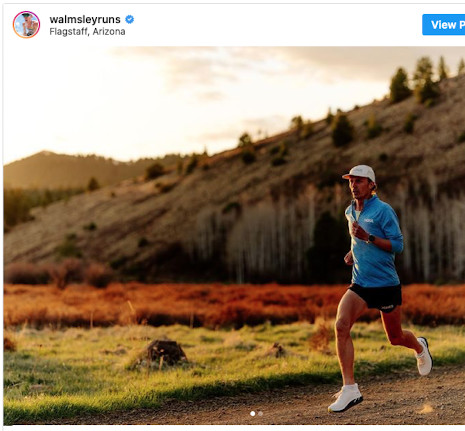
This will be Drew’s second WSER appearance, and she, too, has what it takes to improve on her result from 2019. She has several big wins to her name, including top finishes at the Chuckanut 50K and Canyons 100K in 2019. She has also represented Canada at the IAU Trail World Championships. B.C.’s Sarah Seads will also race in California, making her first WSER appearance.
When it comes to debut WSER runs, there are several big names to watch. New Zealand’s Ruth Croft is having a tremendous season, with a pair of big wins. Her first came at the Tarawera Ultra in Rotorua, New Zealand, where she won the overall title in the 102K race. A few months later, she was in action in Australia, where she won a 50K race in Katoomba, a town west of Sydney, at Ultra-Trail Australia.
France’s Audrey Tanguy is also running WSER for the first time. Tanguy has had a great year so far, first winning the Hoka One One Project Carbon X 2 100K event in Arizona in January and then following it up with a third-place finish at the Canyons 100K in April. She is also a two-time UTMB TDS winner (2018 and 2019).
Finally, there’s American ultrarunning star Camille Herron. The owner of multiple American and world records, Herron is another threat for the win at WSER. She has won the Comrades Marathon, multiple world championships and many other races around the world, and it shouldn’t be a surprise if she adds a top WSER finish to her resume.
Men’s field - The only WSER champion in the 2021 field is Walmsley, who has won the past two editions of the race. In 2018, he won in 14:30:04, and a year later, he set the course record with an incredible 14:09:28 run. This year, he has raced one ultramarathon, Hoka’s Project Carbon X 2, which he won in 6:09:26, coming extremely close to breaking the 100K world record of 6:09:14. That was several months ago, but if his fitness is anywhere close to where it was at that race, he should be able to lay down another historic WSER run.
Walmsley’s fellow American Jared Hazen, the 2019 runner-up, is also set to race this year. In 2019, Hazen ran a remarkable time of 14:26:46, which would have easily won him the WSER title if Walmsley hadn’t been in the race. He’ll be looking to take that final step onto the top of the podium this year.
A pair of Americans making their WSER debuts are Tollefson and Hayden Hawks. Tollefson has several big wins to his name in the past year alone, including titles at the 2020 Javelina Jundred 100 Miler and USATF 50-Mile Trail Championships. He has also recorded victories at the 120K Lavaredo Ultra-Trail race in Italy in 2019 and the 100K Ultra-Trail Australia in 2017, along with a pair of third-place finishes at UTMB in 2016 and 2017.
Hawks has won many races throughout his career, including the JFK 50-Miler in 2020. He set the course record of 5:18:40 at that race, beating Walmsley’s mark of 5:21:28 from 2016. The WSER course is twice as long as the JFK 50, but Hawks has proven he can match or better Walmsley’s efforts, so it will be interesting to see how he fares in California.
by Running Magazine
Login to leave a comment
Hawks soars to JFK 50 victory in record time
With most major running events having been canceled this year due to the COVID-19 pandemic, opportunities were not to be wasted at the 58th annual JFK 50 Mile ultramarathon in Washington County.
No one seized the chance to showcase their fitness quite the way Hayden Hawks did Saturday.
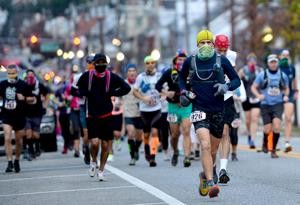
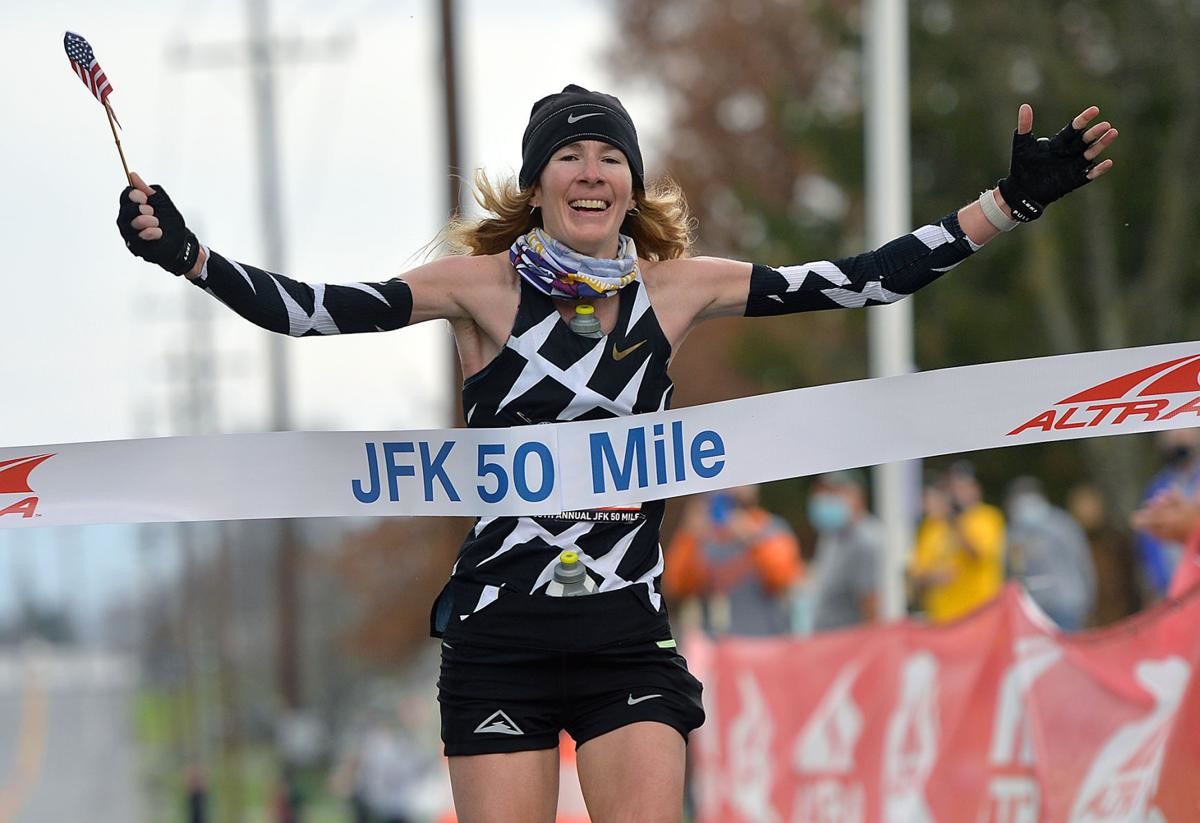
In his debut at the race, Hawks, 29, of Cedar City, Utah, turned in a stunning performance, winning in a course-record time of 5 hours, 18 minutes and 40 seconds — an average of 6:21 per mile.
The women’s title was captured by pre-race favorite Camille Herron in 6:31:14.
“I just really wanted to come out here, have fun and see what I could do. It just all clicked today,” Hawks said. “I kept thinking the whole time during the race how grateful I was to be out here.
“You know, it’s been a hard year for a lot of people, including us as professional athletes. My whole schedule was changed this year. I had all these big plans, competing at all these big things. Of course, all that got canceled, so I just took advantage of the time I had and really dialed everything in — my nutrition, my strength training, my running training — coming into this.
“I was like, you know, I need to be grateful and have gratitude because, really, this might be the first and the last race for a while for me. I was just really fortunate and really happy out there.”
The previous course record was 5:21:29, set by Jim Walmsley in 2016. That was a momentous achievement, as before Saturday, no one else had ever run faster than 5:34:22 in the first 57 years of the event.
“I fully expected Walmsley’s record to stand well into 2040, maybe even 2050,” JFK 50 director Mike Spinnler said. “It was just such a big quantum leap.”
With some help from Walmsley, Hawks took it a step further.
“Jim and I are really good friends. We talk all the time,” Hawks said. “Jim actually gave me some advice coming into this. I was texting him back and forth, asking for shoe advice and what I should do. And he gave me advice.
“He’s a really class-act guy, a really great competitor, and I’m really fortunate to have him as a friend. That’s what we do as competitors. We’re always trying to push each other and reach that next goal. I’m sure Jim is happy for me today to take this course record to the next step, just like I’d be happy for him if he did that as well.”
Stephen Kersh, 29, of Flagstaff, Ariz., placed second in 5:27:07 — the No. 3 performance in race history — in his first JFK.
“I’m definitely pretty happy,” he said. “It was just about as good as it could have been.”
Kersh’s training partners in Flagstaff include Walmsley and two other recent JFK champions, Jared Hazen (2018) and Eric Sensmen (2017).
“I’ve been picking their brains for the last couple months, so I didn’t come into this as green as some people. I knew what to expect,” Kersh said. “Training with those guys, this isn’t as unexpected as maybe some people think, because I’m not really a big name in the sport.”
After the first 15.5-mile segment of the race, mostly comprised of the rocky Appalachian Trail, a lead pack of four — Hawks, Matt Daniels, Hazen and Kersh — took the title fight to the flat C&O Canal towpath for the next 26.3 miles.
“Once we hit the canal path, Matt and I took off,” Hawks said. “We actually train a lot together and are really good friends.
“We talked beforehand about working together on the canal path, and then it would be every man for himself at the end, so that’s what we did. We started clicking off sub-6-minute miles and were feeling very comfortable, having a conversation and feeling really good.
“At Mile 27, I kind of broke Matt a little bit. I think maybe he had a calf injury. He’s been dealing with a lot of injuries over the past few months. Matt on his ‘A’ game would have been hard to beat today.”
Daniels ended up dropping out, and Hazen fell back to a 13th-place finish (6:36:13).
Jonathan Aziz, 29, of Colorado Springs, Colo., finished third in his ultramarathon debut in 5:37:14 — the No. 6 performance in JFK history.
Anthony Kunkel, 28, of Durango, Colo., placed fourth in 5:45:31, and Geoffrey Burns, 30, of Ann Arbor, Mich., took fifth in 5:52:51.
Herron adds to her résumé
In the women’s competition, Herron, 38, of Alamosa, Colo., showed why she was the overwhelming pre-race favorite, leading from start to finish as she won by nearly a half-hour in her first JFK.
Although Herron’s personal record for 50 miles (5:38:41) is an all-time world best, she specializes in even longer events, also owning world-best performances for 100 miles (12:42:40) and 24 hours (167.842 miles).
“Because I was coming down in distance, I felt a little slow and rusty today,” she said.
She had her sights set on the JFK women’s record — 6:12:00, set by Ellie Greenwood in 2012.
Although Herron was off course-record pace on the Appalachian Trail, she had hoped to make up for it on the C&O Canal towpath.
“I was trying to chase time the whole way, and I just didn’t have it. This was the best that I could do today,” she said. “Buy hey, I won. I’m not disappointed for such a crazy year. It’s awesome to even have a race.
“I definitely want to come back,” she said. “I think I have it in me to go for the course record — just keep trying. It’s a stout course record, I can tell you that.”
Sarah Cummings, 31, of Park City, Utah, was the runner-up in 6:57:11, while Haley Moody Gilpin, 31, of Chattanooga, Tenn., placed third in 7:00:52, Alicia Hudelson, 36, of Roswell, Ga., took fourth in 7:14:02, and Sarah Biehl, 26, of Hilliard, Ohio, was fifth in 7:22:32.
Login to leave a comment
Ultra runner Jared Hazen, is focused on winning the Vibram Hong Kong 100km ultramarathon
Jared Hazen is focused on winning the Vibram Hong Kong 100km ultramarathon, starting at 8am on Saturday, by leading the race as early as possible. The American speedster believes that although it is possible to podium by running conservatively, runners need to push from the start to come first.
“I’ve moved up, late in races, to a podium a spot. But trying to win is playing a whole other game, you have to be at the front of race the whole time,” Hazen, 25, said. “You're not going to luckily sneak your way into first place.”
The HK100 is the first race of the Ultra-Trail World Tour (UTWT). It is one of five UTWT races in Asia, including the Ultra-Trail Mount Fuji. It starts in Sai Kung and snakes across the New Territories to Tai Mo Shan.
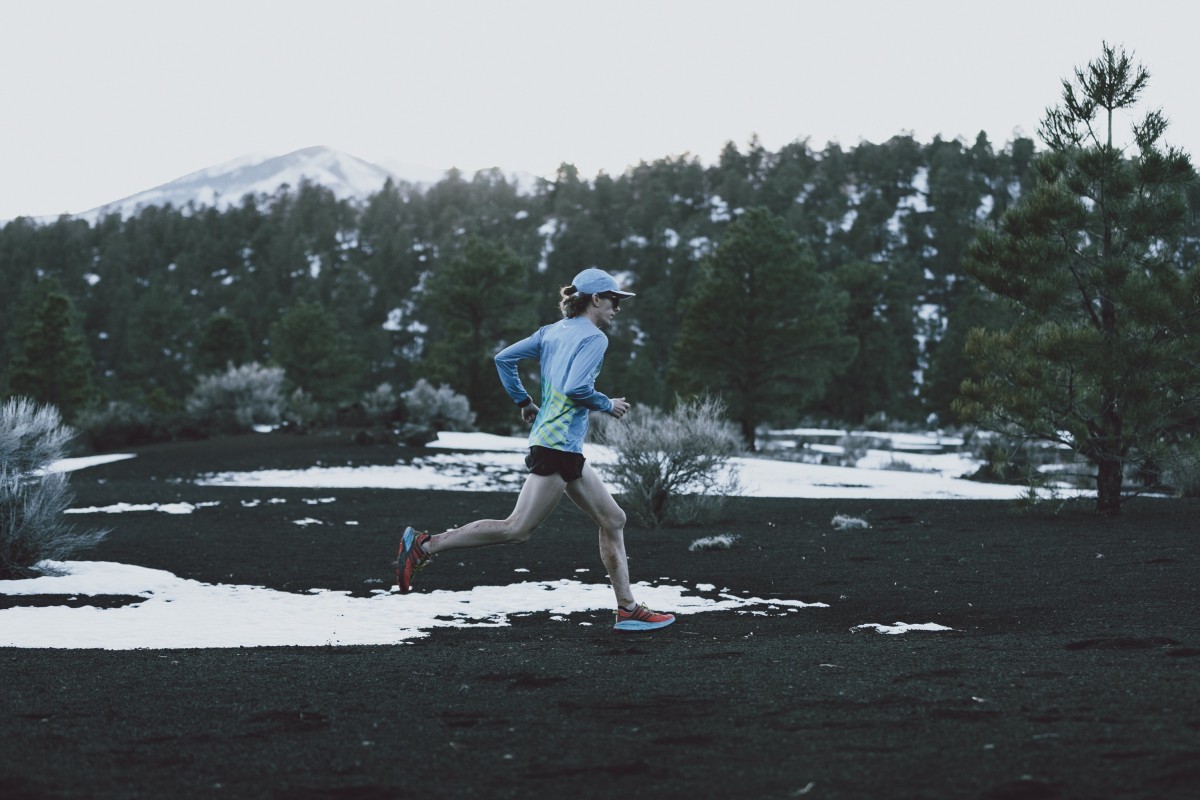
Hazen said in any race, the reports you get in checkpoints about how far other runners are ahead of you can be inaccurate, making it hard to overtake them: “It's better to manage yourself while in the lead.”
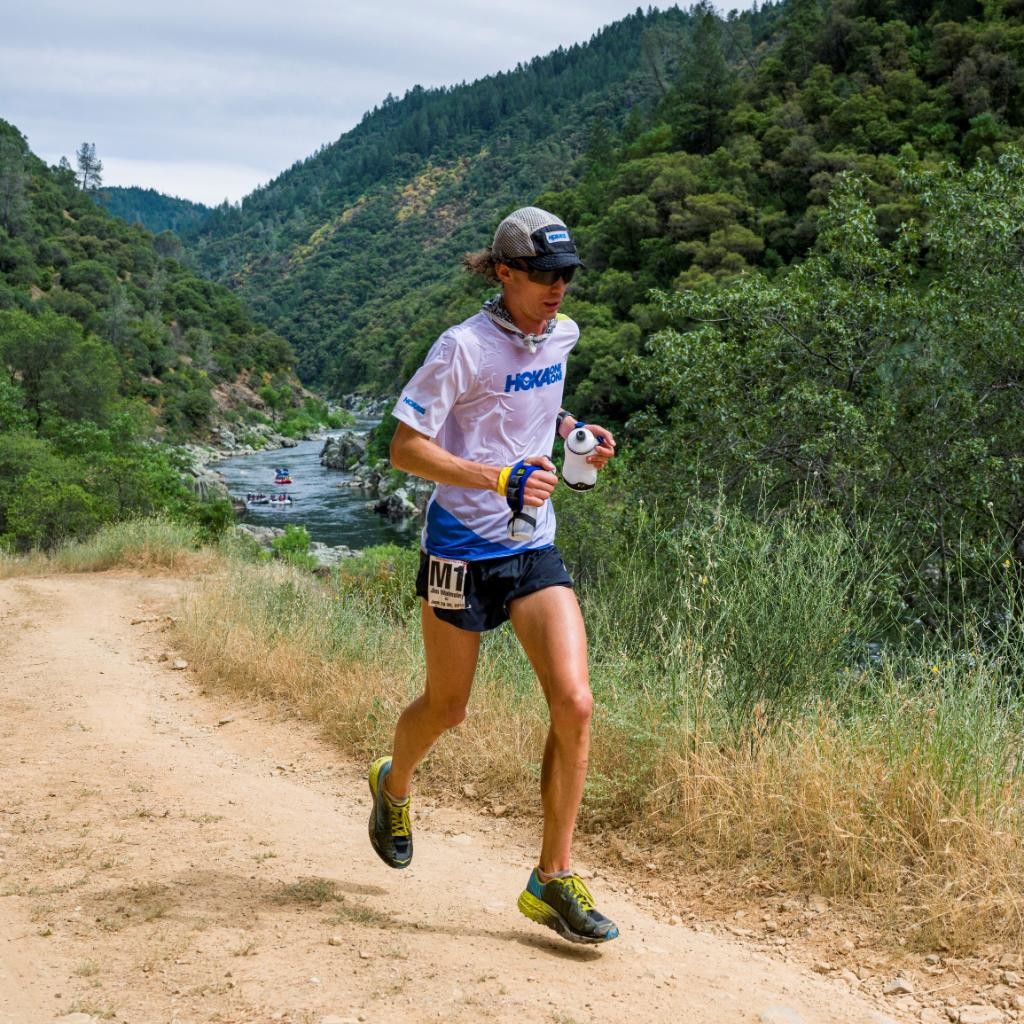
However, pushing from the start is a risk as it is all or nothing, and you can blow up.
“I think it's OK for it to be nothing on some days,” he said. “But you have to hold yourself accountable to a certain extent. Sometimes it was stupid and you blew a chance. But you've got to give yourself a chance. Can you walk away with your head held high?”
Hazen added that although American runners have the reputation for going out hard, with an all or nothing attitude, it was only recently that the Europeans earned the same reputation: “I feel like it’s flip-flopped. But it’s because some faster American athletes have got into the sport recently.”
Owing to the HK100’s UTWT status, the start line is packed with talent. Foreigners, like Hazen, travel to Hong Kong and many unknown but equally talented mainland Chinese runners also attend. The past two editions have been won by mainland Chinese men and women.
Hazen said he knew the Chinese runners by name only. Usually, he is familiar with the field because he races the same events in the US so often. He knows his competitors’ styles, strengths and weaknesses.
“So this will be new. But that is what this year is about a little bit, stretching myself and racing new runners,” he said.
“I've been doing the same races for too long. There are some really cool races on the UTWT and I just want to participate in that more. I want to be more of an international runner and not a US runner,” he said. He is also targeting the Transvulcania in La Palma, Spain, in May and the CCC in Chamonix, France, in August.
Hazen is also returning to the Western States 100 mile (161) this summer, where last year he ran the second-fastest time ever. It would have been the course record had his training mate Jim Walmsley not beaten him that day and set the record.
by Mark Agnew
Login to leave a comment
Vibram Hong Kong 100 Ultra trail
The Vibram® Hong Kong 100 is an ultra endurance race that takes place in Hong Kong. The 103km course starts in Pak Tam Chung on the Sai Kung Peninsula and covers some of the most beautiful scenery in Hong Kong, including remote and unspoilt beaches, ancient forests, nature trails, reservoirs and steep hills. The course is based around Hong Kong's...
more...Boulder’s Ryan Smith wins 2019 Leadville 100 with consistent second-half pacing
Boulder’s Ryan Smith won the Leadville 100 trail run on Saturday night thanks to consistent second-half pacing that left his rivals unable to respond. It was the biggest win of his ultrarunning career.
The Boulder-based runner, who came to the United States from the United Kingdom and works full-time a software engineer, was greeted at the finish by his wife and almost 2-year-old daughter. He turned 40 years old this year.
“There’s just a lot of running in the race,” Smith said, referring to the long flat sections along much of the course. “It really favors a flat runner rather than a mountain runner, and I typically do a lot of mountain stuff.”
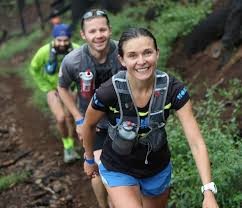
His win — in 16 hours, 33 minutes, 25 seconds — was far from expected. Smith was not among the pre-race favorites to win, and he wasn’t feeling well leading into the Twin Lakes aid station near the 40-mile mark. But at the turnaround at Winfield, he held his pace steady, averaging around 10 minutes per mile for the rest of the race.
“Always be closing!” his last pacesetter, Clare Gallagher, herself a Leadville 100 winner in 2016, yelled to him after his win. She was referring to Smith’s penchant for strong finishes, and to the casual observer, it might have seemed that Smith was surging. But consistent pacing that late in a race — he averaged 9:58, 9:53, 9:59, 9:54, 10:01, 9:55, 9:54 for all of the second half checkpoints — is remarkably difficult to achieve.
His win came after Jared Hazen, the runner-up to this year’s Western States 100, set out a blistering early pace, intent on breaking the course record of 15:42 set by Matt Carpenter in 2005. Late Saturday morning, while racing back toward Twin Lakes, he told a Denver Post reporter along the trail that he had dropped out and “needed to get to an aid station.” He had turned around before the Winfield aid station — the halfway point of the course.
The Leadville is infamous for seducing runners into racing too hard too early, with flat fields and trails before turning into a punishing climb to 12,600 feet over Hope Pass.
For the women, Magdalena Boulet of Oakland, Calif., finished in 20:18:07 in her first Leadville 100. Boulet, who won her first-ever 100-miler in 2015 at Western States and was a U.S. Olympic marathoner in 2008, said she was inspired to run at Leadville after crewing for her boss at GU Energy Labs a few years ago. She had acclimatized at altitude for only two weeks before Saturday’s run. Boulder’s Cat Bradley was the second woman to cross the finish line in 20:45:48.
Login to leave a comment
Leadville Trail 100 Run
The legendary “Race Across The Sky” 100-mile run is where it all started back in 1983. This is it. The race where legends are created and limits are tested. One hundred miles of extreme Colorado Rockies terrain — from elevations of 9,200 to 12,600 feet. You will give the mountain respect, and earn respect from all. ...
more...Jim Walmsley wins Western States 100 smashing his own course record
Jim Walmsley wins the 2019 Western States 100 in a course record 14:09:28, breaking his own course record of 14:30:04 set last year.
“I made up a lot of time pushing pretty good up Robinson, Devil’s Thumb as well, then things began to relax,” he said on the finish line, adding there were a few aid stations when he was not so fresh. “Things started rolling again when I crossed the river.”

“It was a big goal just to come here and try and win. It’s one thing to win at Western States, it’s a once in a lifetime thing, but to do it twice, puts you a bit more ‘two time guy right here.”
Jared Hazen took second at the 2019 Western States 100 in 14:26:46, also under Jim Walmsley’s previous course record.
Before this year’s race Walmsley said his mindset and approach to the race have changed little, and with favorable weather and decent course conditions, a push to again break the record could be in play.

“I might kind of pull things back (from) maybe not running as risky, but at the same time, counter to that, there’s pretty good weather predictions right now,” said Walmsley. “This will be my fourth time racing, fourth year in a row, and it’s by far the coolest year. There’s also that tempting side of it of like, ‘I always want to see what I can run here.”
Walmsley was on a record-breaking pace in 2016, but strayed off course with less than 10 miles to go. He fought through exhaustion to finish 20th with a time of 18:45:36. In 2017, which had a similar amount of snow on the course as this year, Walmsley was several minutes ahead of his 2018 record time during the early portions of the course, but as the day wore on, temperatures climbed past 90 degrees and exhaustion knocked him out of the race with a little more than 20 miles to go.
“Ultimately, it’s about listening to my own pace and just putting everything out there regardless,” he said. “As long as I end up giving my best effort and going to the well to get there, I’m always happy with it. Whether it’s the DNF in 2017 or the course record last year. I’m pretty proud of both days and the fact that I know I gave everything at both races. You can always live with that.”
Coming into this year’s race, Walmsley said he feels he’s matured as a runner, which has given him the confidence to overcome the mental and physical hurdles that arise during a 100-mile race.
Login to leave a comment
Western States 100
The Western States ® 100-Mile Endurance Run is the world’s oldest and most prestigious 100-mile trail race. Starting in Squaw Valley, California near the site of the 1960 Winter Olympics and ending 100.2 miles later in Auburn, California, Western States, in the decades since its inception in 1974, has come to represent one of the ultimate endurance tests in the...
more...

